Antibiotic resistant shiga toxin producing Escherichia coli isolates from milk and milk products

Abstract
Totally 450 milk and milk products (50 each of raw buffalo & cow milk; Kareish, Tallaga and Roquefort cheeses; yoghurt; rayeb; condensed milk and sour cream) samples were randomly purchased from various markets in Kafr El-Sheikh for isolation and identification of STEC. Results showed that 60%, 80%, 30%, 10%, 12%, 20%, 6% and 22% of buffalo & cow milk, Kareish, Roquefort, Tallaga, yoghurt, rayeb and sour cream respectively, contained E.coli, but negative in condensed milk. Fifty suspected isolates were serologically identified using E.coli O157:H7 kits, and confirmed in 69.2%, 53.8%, 60%, 16.7% and 20% isolates of buffalo & cow milk, Kareish, Tallaga and yoghurt, while was negative in Roqufort, rayeb, and sour cream. Using PCR assay, 21 confirmed isolates were examined, 44.4, 71.4, 66.7, 100 and 100% isolates of buffalo & cow milk, Kareish, Tallaga and yoghurt were positive for rfbE gene; while 55.6, 42.8, 66.7, 100 and 100 % isolates of buffalo & cow milk, Kareish, Tallaga and yoghurt were positive for blaTEM, but all isolates were negative for blaCMY2. Consequently, raw milk and most dairy products including fermented products were possible source of E.coli O157:H7food poisoning, so usage of accurate hygienic measures through manufacture and retail of milk products be essential.
Article Details
- How to Cite
-
Sobeih, A., Moawad, A., & Sharshar, T. (2023). Antibiotic resistant shiga toxin producing Escherichia coli isolates from milk and milk products. Journal of the Hellenic Veterinary Medical Society, 74(1), 5283–5288. https://doi.org/10.12681/jhvms.29111 (Original work published April 11, 2023)
- Issue
- Vol. 74 No. 1 (2023)
- Section
- Research Articles

This work is licensed under a Creative Commons Attribution-NonCommercial 4.0 International License.
Authors who publish with this journal agree to the following terms:
· Authors retain copyright and grant the journal right of first publication with the work simultaneously licensed under a Creative Commons Attribution Non-Commercial License that allows others to share the work with an acknowledgement of the work's authorship and initial publication in this journal.
· Authors are able to enter into separate, additional contractual arrangements for the non-exclusive distribution of the journal's published version of the work (e.g. post it to an institutional repository or publish it in a book), with an acknowledgement of its initial publication in this journal.
· Authors are permitted and encouraged to post their work online (preferably in institutional repositories or on their website) prior to and during the submission process, as it can lead to productive exchanges, as well as earlier and greater citation of published work.


